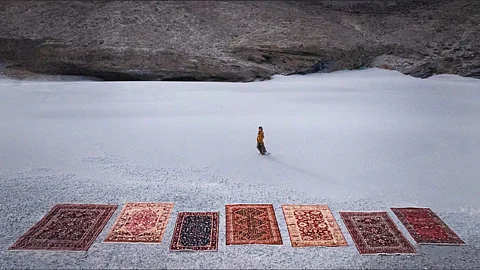
- HOMEGROWN WORLD
- #HGCREATORS
- #HGEXPLORE
- #HGVOICES
- #HGSHOP
- CAREERS
- ABOUT US
- CONTACT US

The Silk Road was an expansive network of ancient trade routes that stretched from China to the Mediterranean, passing through Central Asia, Persia, India, and the Arabian Peninsula like threads on a loom. Flourishing between the 2nd century BCE and the 15th century CE, it was more than a conduit for the trade of silk, spices, and precious goods — it was a vibrant channel of cultural, religious, and artistic exchange. Buddhist monks, Sufi mystics, Arab merchants, as well as pilgrims and emissaries, travelled these paths, carrying with them goods, philosophies, technologies, and stories that reshaped the regions they touched. Located at key junctions along the Silk Road, ancient cities and settlements like Samarkand, Kashgar, and Ladakh became cosmopolitan crossroads, absorbing and transmitting influences that still endure today. The Silk Road played a pivotal role in shaping world history, fostering dialogue between the East and the West long before the age of globalisation. Today, its legacy lingers on in living traditions — architecture, cuisines, and textile traditions born from over a millennium of interconnectedness.
105-year-old homegrown carpet-maker Obeetee's new 'Silk Route' collection draws on the cultural legacy of this ancient trade network, blending Persian, Tibetan, and Mughal designs with Ladakh's rich textile heritage. Drawing from Ladakh's rich visual lexicon with the storied motifs of Persian and Mughal carpets, the collection weaves together diverse design traditions into a unified hand-knotted tapestry. The carpets feature flowing Persian floral strokes, Tibetan sacred geometry, and the opulence of Mughal-inspired motifs remixed with Obeetee's signature contemporary bohemian edge that complements modern interiors.
Once a thriving settlement of nomadic sheep and yak-herders, merchants and monks, Ladakh historically played host to Indian, Tibetan, and Central Asian caravans, all of whom left their imprint on its culture. Today, the region still bears witness to that cultural confluence. Its architecture, rituals, and especially its crafts reflect a unique hybrid aesthetic. Textile traditions in Ladakh are especially rich — from fine-woven woollen Cashmere shawls and felt rugs to intricate Thangka paintings. Yet, despite this deep heritage, these crafts have often remained underrepresented on the national and global stage.
The Silk Route collection attempts to change that. As part of the collection's launch, Obeetee has taken active steps to invest in Ladakh's craft communities and help preserve its traditional skills. In collaboration with a government-supported initiative, the company hosted an intensive 30-day training program in the region, where 50 women artisans were introduced to advanced Tibetan knotting techniques. Led by Obeetee's master weavers, the workshop aimed to provide artisans with technical expertise suited to contemporary markets. The initiative reflects Obeetee's long-term commitment to sustaining Ladakh's handwoven traditions and fostering economic resilience within its artisan networks.
Through the Silk Route collection, Obeetee bridges Ladakh's past and present — reimagining ancient pathways of exchange as tangible objects of beauty and utility. Each carpet from the Silk Route collection carries within it a story of craft, collaboration, collective cultural memory, and revival. In doing so, these carpets invite consumers to walk, literally and metaphorically, on centuries of shared human history.
The Silk Route collection is now available at Obeetee showrooms across India and online at obeetee.com.
